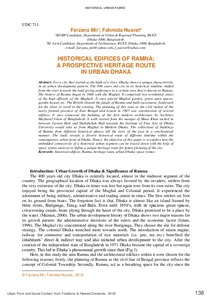HISTORICAL EDIFICES OF RAMNA: A PROSPECTIVE HERITAGE ROUTE IN URBAN DHAKA
Скачать файл:
URI (для ссылок/цитирований):
https://elib.sfu-kras.ru/handle/2311/111684Автор:
Farzana, Mir
Fahmida, Nusrat
(Farzana Mir, Fahmida Nusrat : ¹MURP Candidate, Department of Urban & Regional Planning, BUET, Dhaka-1000, Bangladesh. ²M.Arch Candidate, Department of Architecture, BUET, Dhaka-1000, Bangladesh. E-mail: farzana_mir@yahoo.com,f_nusrat@yahoo.com)
Дата:
2019-05Proceedings of the XXV ISUF International Conference “Urban Form and Social Context: from Traditions to Newest Demands” (Krasnoyarsk, July 5–9, 2018)
Аннотация:
For a city that started at the bank of a river, Dhaka shows a unique characteristic in its urban development pattern. The 400 years old city in its historical timeline shifted from the river towards the land giving preference to a certain area that is known as Ramna. The history of Ramna began in 1608 with the Mughal. It comprised two residential areas of the high officials of the Mughals. It once placed Mughal garden, green open spaces, garden houses etc. The British cleared the jungle of Ramna and built racecourse, boulevard for the elites to stroll in the evening. The planning of this area as the civil station of the newly formed province of East Bengal and Assam in 1905 saw construction of several edifices. It also witnessed the building of the first modern architecture by Architect Mazharul Islam of Bangladesh. A walk started from the mosque of Musa Khan tucked in between Curzon Hall and Shahidullah Hall towards the Institute of Fine Arts of Dhaka University would take us from Mughal to Modern Dhaka. The collections of buildings of Ramna from different historical phases tell the story of the past in a synchronized manner. The study reveals a diverse historical route of different timeline within the contemporary urban form of Dhaka.
Hence, the objective of this paper is to explore how the embedded connectivity of a historical urban segment can be traced down with the help of space syntax analysis to define a unique heritage route for future planning of the city.

